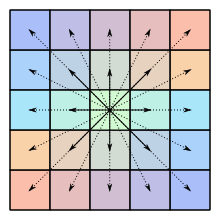Centrosymmetric matrix

In mathematics, especially in linear algebra and matrix theory, a centrosymmetric matrix is a matrix which is symmetric about its center. More precisely, an n × n matrix A = [ Ai,j ] is centrosymmetric when its entries satisfy
- Ai,j = An−i+1,n−j+1 for 1 ≤ i,j ≤ n.
If J denotes the n × n matrix with 1 on the counterdiagonal and 0 elsewhere (that is, Ji,n+1-i = 1; Ji,j = 0 if j ≠ n+1-i), then a matrix A is centrosymmetric if and only if AJ = JA. The matrix J is sometimes referred to as the exchange matrix.
Examples
- All 2×2 centrosymmetric matrices have the form
- All 3×3 centrosymmetric matrices have the form
Algebraic structure
If A and B are centrosymmetric matrices over a given field K, then so are A+B and cA for any c in K. In addition, the matrix product AB is centrosymmetric, since JAB = AJB = ABJ. Since the identity matrix is also centrosymmetric, it follows that the set of n × n centrosymmetric matrices over K is a subalgebra of the associative algebra of all n × n matrices.
Related structures
An n × n matrix A is said to be skew-centrosymmetric if its entries satisfy Ai,j = -An−i+1,n−j+1 for 1 ≤ i,j ≤ n. Equivalently, A is skew-centrosymmetric if AJ = -JA, where J is the exchange matrix defined above.
The centrosymmetric relation AJ = JA lends itself to a natural generalization, where J is replaced with an involutory matrix K (i.e., K2 = I)[1] [2] [3] or, more generally, a matrix K satisfying Km = I for an integer m > 1.[4] The inverse problem for the commutation relation AK = KA, of identifying all involutory K that commute with a fixed matrix A, has also been studied.[4]
Symmetric centrosymmetric matrices are sometimes called bisymmetric matrices. When the ground field is the field of real numbers, it has been shown that bisymmetric matrices are precisely those symmetric matrices whose eigenvalues are the same up to sign after pre or post multiplication by the exchange matrix.[2] A similar result holds for Hermitian centrosymmetric and skew-centrosymmetric matrices.[5]
References
- ↑ Andrew, A. (1973). "Eigenvectors of certain matrices". Linear Algebra Appl. 7 (2): 151–162. doi:10.1016/0024-3795(73)90049-9.
- 1 2 Tao, D.; Yasuda, M. (2002). "A spectral characterization of generalized real symmetric centrosymmetric and generalized real symmetric skew-centrosymmetric matrices". SIAM J. Matrix Anal. Appl. 23 (3): 885–895. doi:10.1137/S0895479801386730.
- ↑ Trench, W. F. (2004). "Characterization and properties of matrices with generalized symmetry or skew symmetry". Linear Algebra Appl. 377: 207–218. doi:10.1016/j.laa.2003.07.013.
- 1 2 Yasuda, M. (2012). "Some properties of commuting and anti-commuting m-involutions". Acta Mathematica Scientia. 32 (2): 631–644. doi:10.1016/S0252-9602(12)60044-7.
- ↑ Yasuda, M. (2003). "A Spectral Characterization of Hermitian Centrosymmetric and Hermitian Skew-Centrosymmetric K-Matrices". SIAM J. Matrix Anal. Appl. 25 (3): 601–605. doi:10.1137/S0895479802418835.
Further reading
- Muir, Thomas (1960). A Treatise on the Theory of Determinants. Dover. p. 19. ISBN 0-486-60670-8.
- Weaver, J. R. (1985). "Centrosymmetric (cross-symmetric) matrices, their basic properties, eigenvalues, and eigenvectors". American Mathematical Monthly. 92 (10): 711–717. doi:10.2307/2323222. JSTOR 2323222.